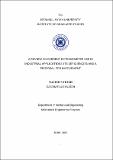Please use this identifier to cite or link to this item:
http://hdl.handle.net/11547/10726| Title: | A REVIEW ON CURRENT EXTENSOMETER USE IN INDUSTRIAL APPLICATIONS, ITS DEFICIENCIES AND A PROPOSAL FOR IMPOVEMENT |
| Authors: | FAUZI NADDI, GASSIM |
| Issue Date: | 2023 |
| Publisher: | ISTANBUL AYDIN UNIVERSITY INSTITUTE OF SOCIAL SCIENCES |
| Abstract: | Extensometers are mechanical devices used to measure changes in length or strain in materials under stress or deformation. They provide valuable data for evaluating material properties, structural integrity, and mechanical behavior. One specific type of extensometer is the bolt-on extensometer, which is easily mounted onto the surface of a specimen using bolts or clamps. This thesis project aims to investigate and analyze the role of extensometers and bolt-on extensometers in measuring strain and deformation in materials, focusing on their advantages and potential failure modes. Extensometers are widely used mechanical devices in engineering, material testing, and research to assess material properties and structural behavior. Bolt-on extensometers, a specific type of extensometer, offer the advantage of easy installation without damaging the specimen. The study begins with an in-depth literature review to understand the theoretical background, working principles, and applications of extensometers and bolt-on extensometers. The advantages of extensometers lie in their ability to provide accurate and reliable measurements of strain. They aid in the design, optimization, and safety assessment of structures. The thesis project also investigates the specific advantages of bolt-on extensometers, which include non-destructive testing capabilities and versatility in measuring strain in delicate or composite materials. The easy installation and removal iv of bolt-on extensometers make them suitable for various testing scenarios, both in laboratory settings and in the field. However, the research also delves into the potential failure modes of bolt-on extensometers. Mechanical issues such as arm or jaw failures, contact point discrepancies, or central body malfunctions can lead to inaccurate or inconsistent measurements. Calibration problems and environmental factors, such as extreme temperatures or corrosive substances, can also affect the performance of these devices |
| URI: | http://hdl.handle.net/11547/10726 |
| Appears in Collections: | Tezler -- Thesis |
Files in This Item:
| File | Description | Size | Format | |
|---|---|---|---|---|
| 10569251.pdf | 1.07 MB | Adobe PDF |  View/Open |
Items in DSpace are protected by copyright, with all rights reserved, unless otherwise indicated.
